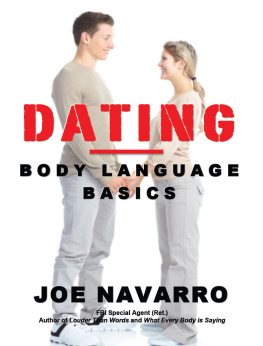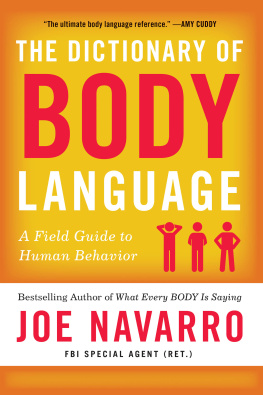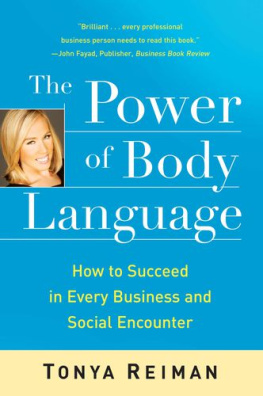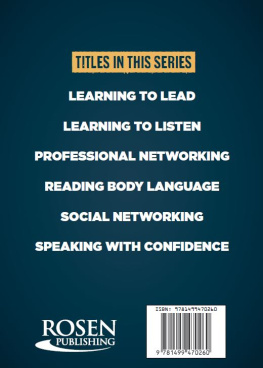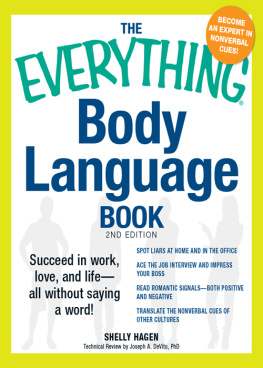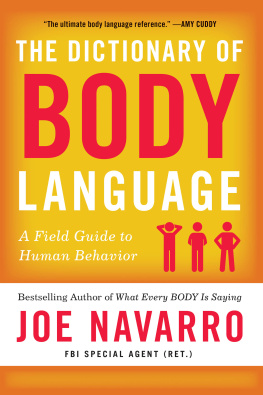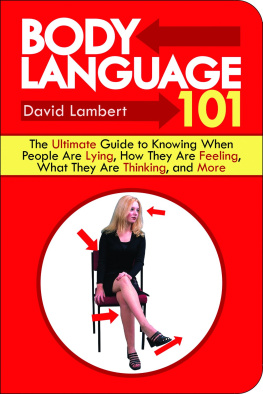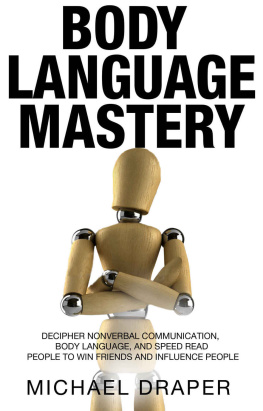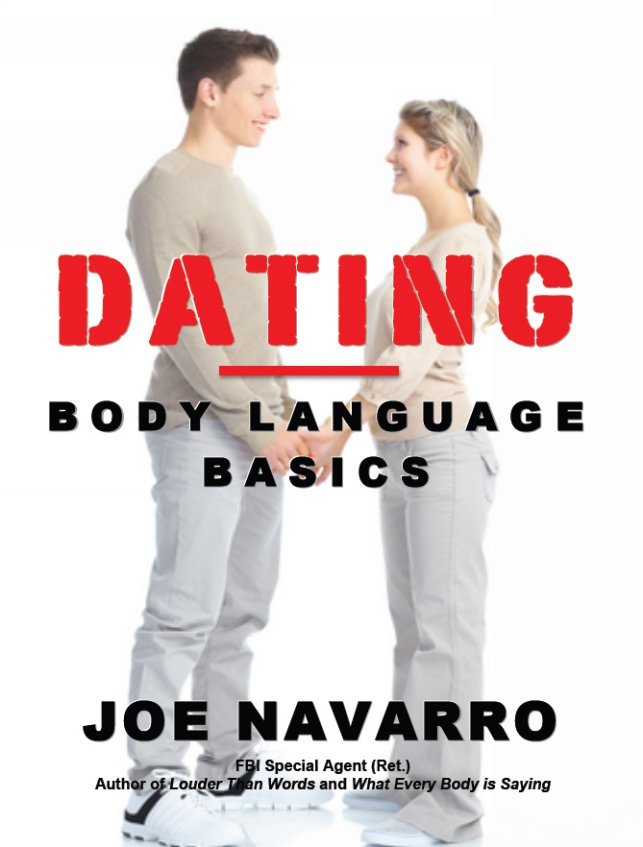
Dating Body Language Basics
Copyright 20 11 Joe Navarro
All rights reserved. No part of this book may be used or reproduced in any manner whatsoever without written permission from the author, except in the case of brief quotations used in articles and reviews.
Front cover photograph courtesy of Kurhan | Dreamstime.com
Photography for all the behaviors except Eyes, Palmar Touching, Ventral Denial/Fronting and Feet is by Mark Wemple. Design by www.marketingintelligently.com
The views expressed in this work are solely those of the author.
For more information, please visit www.jnforensics.com
###
Contents
Introduction
The Eyes
The Nose
The Lips
The Lips are Gone
The Look
The Neck
The Torso
The Hands
The Fingers
The Feet
Concluding Thoughts
Bibliography
About the Author
Introduction
After studying nonverbal communications for over 35 years and writing several books on the subject, I can sympathize when people say they feel overwhelmed trying to understand the many thousands of messages our bodies transmit.
I am regularly asked if there were a handful of beha viors that everyone should know for dating, what would they be. In essence, which behaviors most accurately reflect what someone is feeling or thinking, even desiring. This brief guide aims to do just that; provide you with what I believe are the most important must know body language cues for dating and good relationships. These behaviors were chosen because they are often missed or not understood and yet, time and time again, they can be relied upon for their accuracy. They are universally useful in revealing the hidden meaning of what we feel and how others feel about us and unfortunately most books on body language and dating fail to mention them.
But before we get started , I want to share with you a useful model to use when reading a persons body language. Those of you who are familiar with my international bestselling book, What Every Body Is Saying , will know that I believe it is essential to focus primarily on two fundamental areas when reading a persons body language: comfort and discomfort .
Our brains limbic system, responsible for emotions and survival, communicates through our body language our emotions and how we feel about others; in essence, what is in our hearts and minds. For millions of years we have communicated our thoughts and sentiments to each other nonverbally this way and we still do. In fact, as much as 80% of what we say in dating or interpersonal communications is nonverbal.
Fortunately, our limbic brain is always on, subconsciously assessing for anything that might be a threat to us or which makes us uncomfortable and it will react immediately to any messages it receives. So when someone looks mean at us or turns away from us, it is our limbic system that reacts to that message and we feel a high degree of discomfort. Similarly when someone looks at us with loving care, our limbic brain also reacts, flushing blood to the skin, relaxing facial muscles, literally orienting our bodies toward that affection.
The limbic system not only reacts to the world, i t also seeks to make us comfortable. So when someone says something we dont like we distance ourselves by leaning away or placing objects between us (a purse or even a crossed leg) so that we can have a little more comfort.
Because limbic-driven behaviors occur instantaneously without thought, unlike the spoken word, they always reflect our exact sentiments (which is why the limbic brain is also referred to as the honest brain). When someone you dont like enters the room, you will immediately and without conscious thought, emotionally react to that person. Your face may reflect your feelings (squinting eyes) or your whole body may react by turning slightly away or by avoiding eye contact. In all cases, what your brain has processed will be reflected in your body language.
Simply put, i n life, we either like or dislike something, we feel contented or unhappy, we feel relaxed or anxious, we are confident or we lack confidence. Think about it, as babies, we are born to display comfort or discomfort nonverbally and that is how we primarily communicate. By accurately reflecting what we think or feel, our bodies transmit valuable information to others. This is what Body Language Essentials for Dating seeks to do in a short amount of space so that that you can more accurately read what others are feeling, thinking, desiring or even intending.
The Eyes
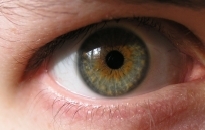
Our eyes are formidable communicators of feelings, thoughts and desires. From the moment we are born, our eyes exquisitely communicate our true feelings, comfort, and emotions. They communicate positive emotions such as excitement, anticipation, happiness, etc., but they also reveal negative emotions, such as fear, apprehension, sadness, and discomfort. The eyes are said to be windows to the soul and I suspect there is a lot of truth to that.
When it comes to relationships and dating, the eyes serve to communicate the interest, passion, or love that we harbor. During the early stages of courtship or dating, there is so much staring and gazing because the eyes communicate so much information. We are mesmerized with the eyes when we date as we seek clues and information from them while we explore them with childlike interest reacting to their reactions, yearning for signs of affection. And so when the pupils dilate we feel comfortable and welcome, but when they constrict, we recognize immediately that something has changed and we are on notice.
Those changes we see in the eyes reflect what is going on in the brain and often it lets us know there are issues. No doubt you have seen someone who while concentrating on a task broadcasts the difficulty they are experiencing through their struggling and bewildered eyes. That is the beauty of the eyes they are so honest in revealing what is being felt or processed by the brain, in real time.
In reaction to whatever the world confronts us with, our eyes react accordingly. A neighbor tells us they accidentally ran into our car and our eyelids may come down heavily or we may rub our eyelids with our fingers. The message is the same, I didnt want to hear that, and yet we smile because we are good friends. But that honest blocking reaction (lids down, covering of eyes with fingers) quickly and honestly conveys our sentiments, even though we wish circumstances were otherwise. This is no different than when someone cancels a date and we find our eyelids come down hard, reflecting what we genuinely feel at that moment. That is the elegant beauty of the eyes, possessing the quickest muscles in our bodies, they communicate efficiently and instantly what we are thinking or feeling before we have a conscious thought.
When relationships begin to falter, eye contact and eye behavior changes also telegraphing in advance that something is amiss. Obvious signs such as eye avoidance, rolling of the eyes, cringing, and so forth are common displays that something is at issue . Then there are other associated eye behaviors that may or may not be recognized such as: the subtle squint at the mention of a topic, the frozen look of despair or apprehension, eye avoidance, the look of disdain or indifference, even of conflicted thoughts and feelings. All communicated by the eyes, all accurate despite what the person may say. After all, how many times have we reacted to something accurately with our body language and then we negated it verbally for the sake of social relations?
Next page
